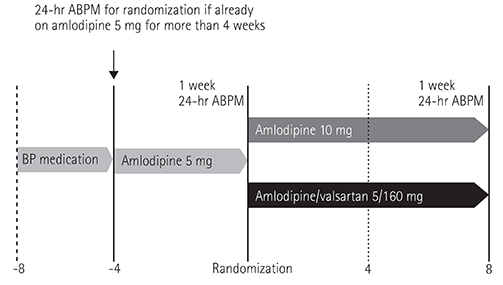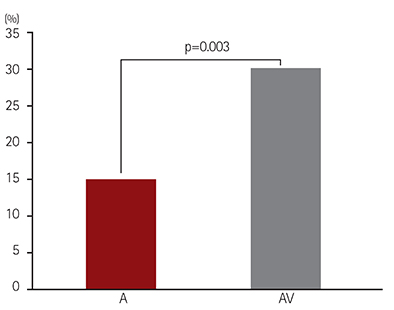Korean Circ J.
2016 Mar;46(2):222-228. 10.4070/kcj.2016.46.2.222.
Valsartan 160 mg/Amlodipine 5 mg Combination Therapy versus Amlodipine 10 mg in Hypertensive Patients with Inadequate Response to Amlodipine 5 mg Monotherapy
- Affiliations
-
- 1Division of Cardiology, Department of Medicine, Heart Vascular and Stroke Institute, Samsung Medical Center, Sungkyunkwan University School of Medicine, Seoul, Korea. jepark39@gmail.com
- 2Division of Cardiology, Department of Internal Medicine, Chungnam National University Hospital, Chungnam National University School of Medicine, Daejeon, Korea.
- 3Department of Internal Medicine, Vision 21 Cardiac and Vascular Center, Ilsan Paik Hospital, Inje University College of Medicine, Goyang, Korea.
- 4Department of Cardiology, Cardiovascular Center, Seoul Medical Center, Seoul, Korea.
- 5Division of Cardiology, Department of Internal Medicine, Kangbuk Samsung Hospital, Sungkyunkwan University School of Medicine, Seoul, Korea.
- 6Division of Interventional Cardiology, Department of Internal Medicine, Kangwon National University Hospital, Chooncheon, Korea.
- 7Department of Cardiovascular Medicine, Kyung Hee University Medical Center, Seoul, Korea.
- 8Cardiology Division, Internal medicine, Eulji University Hospital, Daejeon, Korea.
- 9Department of Cardiology, Center for Clinical Specialty, National Cancer Center, Goyang, Korea.
- 10Division of Cardiology, Department of Internal Medicine, Dankook University Hospital, Cheonan, Korea.
- KMID: 2344474
- DOI: http://doi.org/10.4070/kcj.2016.46.2.222
Abstract
- BACKGROUND AND OBJECTIVES
When monotherapy is inadequate for blood pressure control, the next step is either to continue monotherapy in increased doses or to add another antihypertensive agent. However, direct comparison of double-dose monotherapy versus combination therapy has rarely been done. The objective of this study is to compare 10 mg of amlodipine with an amlodipine/valsartan 5/160 mg combination in patients whose blood pressure control is inadequate with amlodipine 5 mg.
SUBJECTS AND METHODS
This study was conducted as a multicenter, open-label, randomized controlled trial. Men and women aged 20-80 who were diagnosed as having hypertension, who had been on amlodipine 5 mg monotherapy for at least 4 weeks, and whose daytime mean systolic blood pressure (SBP) ≥135 mmHg or diastolic blood pressure (DBP) ≥85 mmHg on 24-hour ambulatory blood pressure monitoring (ABPM) were randomized to amlodipine (A) 10 mg or amlodipine/valsartan (AV) 5/160 mg group. Follow-up 24-hour ABPM was done at 8 weeks after randomization.
RESULTS
Baseline clinical characteristics did not differ between the 2 groups. Ambulatory blood pressure reduction was significantly greater in the AV group compared with the A group (daytime mean SBP change: -14±11 vs. -9±9 mmHg, p<0.001, 24-hour mean SBP change: -13±10 vs. -8±8 mmHg, p<0.0001). Drug-related adverse events also did not differ significantly (A:AV, 6.5 vs. 4.5%, p=0.56).
CONCLUSION
Amlodipine/valsartan 5/160 mg combination was more efficacious than amlodipine 10 mg in hypertensive patients in whom monotherapy of amlodipine 5 mg had failed.
MeSH Terms
Figure
Reference
-
1. Park CG. Recent update on fixed combinations of antihypertensive agents. Korean Circ J. 2008; 38:237–243.2. Philipp T, Glazer RD, Wernsing M, Yen J. Initial combination therapy with amlodipine/valsartan compared with monotherapy in the treatment of hypertension. J Am Soc Hypertens. 2011; 5:417–424.3. Ke Y, Zhu D, Hong H, et al. Efficacy and safety of a single-pill combination of amlodipine/valsartan in Asian hypertensive patients inadequately controlled with amlodipine monotherapy. Curr Med Res Opin. 2010; 26:1705–1713.4. Schunkert H, Glazer RD, Wernsing M, et al. Efficacy and tolerability of amlodipine/valsartan combination therapy in hypertensive patients not adequately controlled on amlodipine monotherapy. Curr Med Res Opin. 2009; 25:2655–2662.5. Ke YN, Huang J, Zhu JR. Valsartan/Amlodipine Single Pill Combination Study Group. Amlodipine Single Pill Combination Study Group. Efficacy and safety of the single pill combination of valsartan 80 mg plus amlodipine 5 mg in mild to moderate essential hypertensive patients without adequate blood pressure control by monotherapy. Zhonghua Xin Xue Guan Bing Za Zhi. 2009; 37:794–799.6. Zhu D, Yang K, Sun N, et al. Amlodipine/valsartan 5/160 mg versus valsartan 160 mg in Chinese hypertensives. Int J Cardiol. 2013; 167:2024–2030.7. Allemann Y, Fraile B, Lambert M, Barbier M, Ferber P, Izzo JL Jr. Efficacy of the combination of amlodipine and valsartan in patients with hypertension uncontrolled with previous monotherapy: the Exforge in Failure after Single Therapy (EX-FAST) study. J Clin Hypertens (Greenwich). 2008; 10:185–194.8. Brachmann J, Ansari A, Mahla G, Handrock R, Klebs S. Effective and safe reduction of blood pressure with the combination of amlodipine 5 mg and valsartan 160 mg in hypertensive patients not controlled by calcium channel blocker monotherapy. Adv Ther. 2008; 25:399–411.9. Sinkiewicz W, Glazer RD, Kavoliuniene A, et al. Efficacy and tolerability of amlodipine/valsartan combination therapy in hypertensive patients not adequately controlled on valsartan monotherapy. Curr Med Res Opin. 2009; 25:315–324.10. Flack JM, Calhoun DA, Satlin L, Barbier M, Hilkert R, Brunel P. Efficacy and safety of initial combination therapy with amlodipine/valsartan compared with amlodipine monotherapy in black patients with stage 2 hypertension: the EX-STAND study. J Hum Hypertens. 2009; 23:479–489.11. Wald DS, Law M, Morris JK, Bestwick JP, Wald NJ. Combination therapy versus monotherapy in reducing blood pressure: meta-analysis on 11,000 participants from 42 trials. Am J Med. 2009; 122:290–300.12. Ogawa H, Kim-Mitsuyama S, Matsui K, et al. Angiotensin II receptor blocker-based therapy in Japanese elderly, high-risk, hypertensive patients. Am J Med. 2012; 125:981–990.13. Philipp T, Smith TR, Glazer R, et al. Two multicenter, 8-week, randomized, double-blind, placebo-controlled, parallel-group studies evaluating the efficacy and tolerability of amlodipine and valsartan in combination and as monotherapy in adult patients with mild to moderate essential hypertension. Clin Ther. 2007; 29:563–580.14. Messerli FH, Oparil S, Feng Z. Comparison of efficacy and side effects of combination therapy of angiotensin-converting enzyme inhibitor (benazepril) with calcium antagonist (either nifedipine or amlodipine) versus high-dose calcium antagonist monotherapy for systemic hypertension. Am J Cardiol. 2000; 86:1182–1187.15. White WB, Calhoun DA, Samuel R, Taylor AA, Zappe DH, Purkayastha D. Improving blood pressure control: increase the dose of diuretic or switch to a fixed-dose angiotensin receptor blocker/diuretic? the valsartan hydrochlorothiazide diuretic for initial control and titration to achieve optimal therapeutic effect (Val-DICTATE) trial. J Clin Hypertens (Greenwich). 2008; 10:450–458.16. Schrader J, Salvetti A, Calvo C, et al. The combination of amlodipine/valsartan 5/160 mg produces less peripheral oedema than amlodipine 10 mg in hypertensive patients not adequately controlled with amlodipine 5 mg. Int J Clin Pract. 2009; 63:217–225.17. Fogari R, Zoppi A, Derosa G, et al. Effect of valsartan addition to amlodipine on ankle oedema and subcutaneous tissue pressure in hypertensive patients. J Hum Hypertens. 2007; 21:220–224.
- Full Text Links
- Actions
-
Cited
- CITED
-
- Close
- Share
- Similar articles
-
- Clinical Course in Patients with an Intentional Amlodipine Overdose
- Pharmacokinetic comparison between fixed-dose combination of fimasartan/amlodipine 60/10 mg and the corresponding loose combination through partial replicated crossover study in healthy subjects
- Pharmacokinetic comparison between a fixed-dose combination of fimasartan/amlodipine/ hydrochlorothiazide 60/10/25 mg and a corresponding loose combination of fimasartan/amlodipine 60/25 mg and hydrochlorothiazide 25 mg in healthy subjects
- Addition of Amlodipine or Valsartan for Improvement of Diastolic Dysfunction Associated with Hypertension
- Amlodipine monotherapy in patients with essential hypertension



